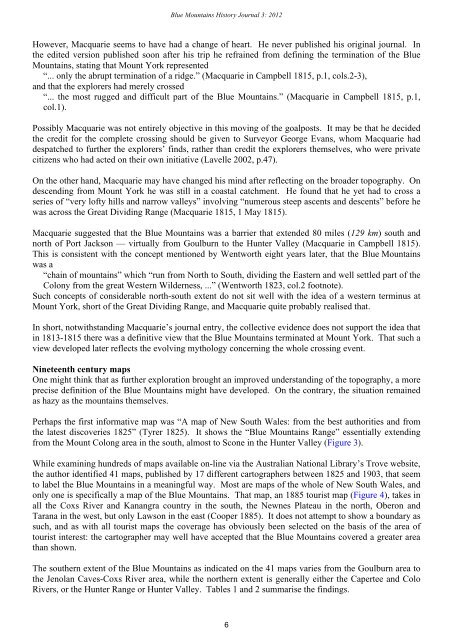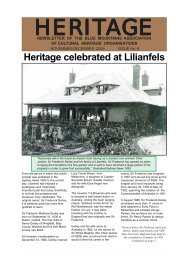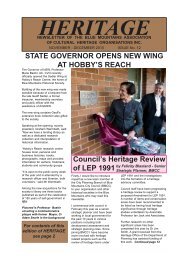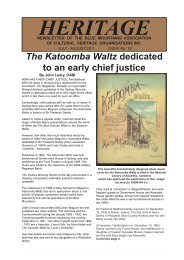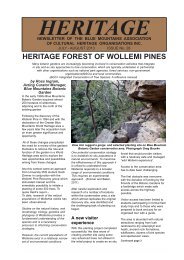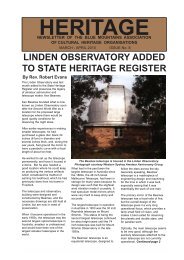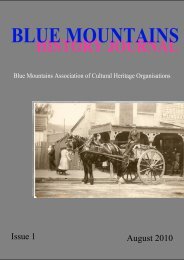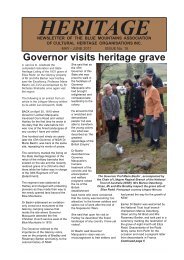Blue Mountains History Journal Issue 3
Blue Mountains History Journal Issue 3
Blue Mountains History Journal Issue 3
You also want an ePaper? Increase the reach of your titles
YUMPU automatically turns print PDFs into web optimized ePapers that Google loves.
<strong>Blue</strong> <strong>Mountains</strong> <strong>History</strong> <strong>Journal</strong> 3: 2012<br />
However, Macquarie seems to have had a change of heart. He never published his original journal. In<br />
the edited version published soon after his trip he refrained from defining the termination of the <strong>Blue</strong><br />
<strong>Mountains</strong>, stating that Mount York represented<br />
“... only the abrupt termination of a ridge.” (Macquarie in Campbell 1815, p.1, cols.2-3),<br />
and that the explorers had merely crossed<br />
“... the most rugged and difficult part of the <strong>Blue</strong> <strong>Mountains</strong>.” (Macquarie in Campbell 1815, p.1,<br />
col.1).<br />
Possibly Macquarie was not entirely objective in this moving of the goalposts. It may be that he decided<br />
the credit for the complete crossing should be given to Surveyor George Evans, whom Macquarie had<br />
despatched to further the explorers’ finds, rather than credit the explorers themselves, who were private<br />
citizens who had acted on their own initiative (Lavelle 2002, p.47).<br />
On the other hand, Macquarie may have changed his mind after reflecting on the broader topography. On<br />
descending from Mount York he was still in a coastal catchment. He found that he yet had to cross a<br />
series of “very lofty hills and narrow valleys” involving “numerous steep ascents and descents” before he<br />
was across the Great Dividing Range (Macquarie 1815, 1 May 1815).<br />
Macquarie suggested that the <strong>Blue</strong> <strong>Mountains</strong> was a barrier that extended 80 miles (129 km) south and<br />
north of Port Jackson — virtually from Goulburn to the Hunter Valley (Macquarie in Campbell 1815).<br />
This is consistent with the concept mentioned by Wentworth eight years later, that the <strong>Blue</strong> <strong>Mountains</strong><br />
was a<br />
“chain of mountains” which “run from North to South, dividing the Eastern and well settled part of the<br />
Colony from the great Western Wilderness, ...” (Wentworth 1823, col.2 footnote).<br />
Such concepts of considerable north-south extent do not sit well with the idea of a western terminus at<br />
Mount York, short of the Great Dividing Range, and Macquarie quite probably realised that.<br />
In short, notwithstanding Macquarie’s journal entry, the collective evidence does not support the idea that<br />
in 1813-1815 there was a definitive view that the <strong>Blue</strong> <strong>Mountains</strong> terminated at Mount York. That such a<br />
view developed later reflects the evolving mythology concerning the whole crossing event.<br />
Nineteenth century maps<br />
One might think that as further exploration brought an improved understanding of the topography, a more<br />
precise definition of the <strong>Blue</strong> <strong>Mountains</strong> might have developed. On the contrary, the situation remained<br />
as hazy as the mountains themselves.<br />
Perhaps the first informative map was “A map of New South Wales: from the best authorities and from<br />
the latest discoveries 1825” (Tyrer 1825). It shows the “<strong>Blue</strong> <strong>Mountains</strong> Range” essentially extending<br />
from the Mount Colong area in the south, almost to Scone in the Hunter Valley (Figure 3).<br />
While examining hundreds of maps available on-line via the Australian National Library’s Trove website,<br />
the author identified 41 maps, published by 17 different cartographers between 1825 and 1903, that seem<br />
to label the <strong>Blue</strong> <strong>Mountains</strong> in a meaningful way. Most are maps of the whole of New South Wales, and<br />
only one is specifically a map of the <strong>Blue</strong> <strong>Mountains</strong>. That map, an 1885 tourist map (Figure 4), takes in<br />
all the Coxs River and Kanangra country in the south, the Newnes Plateau in the north, Oberon and<br />
Tarana in the west, but only Lawson in the east (Cooper 1885). It does not attempt to show a boundary as<br />
such, and as with all tourist maps the coverage has obviously been selected on the basis of the area of<br />
tourist interest: the cartographer may well have accepted that the <strong>Blue</strong> <strong>Mountains</strong> covered a greater area<br />
than shown.<br />
The southern extent of the <strong>Blue</strong> <strong>Mountains</strong> as indicated on the 41 maps varies from the Goulburn area to<br />
the Jenolan Caves-Coxs River area, while the northern extent is generally either the Capertee and Colo<br />
Rivers, or the Hunter Range or Hunter Valley. Tables 1 and 2 summarise the findings.<br />
6


